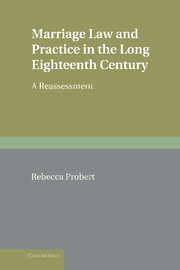Book contents
- Frontmatter
- Contents
- Preface
- 1 Introduction
- 2 The misunderstood contract per verba de praesenti
- 3 The myths of ‘informal’ and ‘common-law’ marriage
- 4 The little-considered marriage practices of non-Anglicans
- 5 The unacknowledged regularity of clandestine marriages
- 6 The eventual passage and actual terms of the 1753 Act
- 7 The unappreciated success of the 1753 Act
- 8 The unexplored judicial interpretation of the 1753 Act
- 9 The overlooked response of non-Anglicans
- 10 Conclusion
- Index
- References
5 - The unacknowledged regularity of clandestine marriages
Published online by Cambridge University Press: 10 February 2010
- Frontmatter
- Contents
- Preface
- 1 Introduction
- 2 The misunderstood contract per verba de praesenti
- 3 The myths of ‘informal’ and ‘common-law’ marriage
- 4 The little-considered marriage practices of non-Anglicans
- 5 The unacknowledged regularity of clandestine marriages
- 6 The eventual passage and actual terms of the 1753 Act
- 7 The unappreciated success of the 1753 Act
- 8 The unexplored judicial interpretation of the 1753 Act
- 9 The overlooked response of non-Anglicans
- 10 Conclusion
- Index
- References
Summary
As noted in the opening chapter, the term ‘clandestine marriage’ bore a specific meaning in the period before the 1753 Act, denoting a marriage that was celebrated before an ordained clergyman of the Church of England otherwise than in accordance with the prescriptions of the canon law. As with the informal exchange of vows and non-Anglican ceremonies, it is necessary to pose our two key questions: how far were clandestine marriages a full alternative to a regular marriage, and how far were they a functional alternative? The second and third sections of this chapter address each in turn, examining the legal consequences (good and bad) that flowed from a clandestine marriage, and then considering how prevalent such marriages were in the first part of the eighteenth century.
Yet in this context there is also another important question that needs to be addressed. To view a clandestine marriage simply as an alternative to a regular marriage may be to miss the point. Clandestine marriages varied considerably: at one end of the spectrum there were the more disreputable couplings celebrated within the Rules of the Fleet prison; at the other, there were marriages actually celebrated in church that were clandestine only in that they did not comply with all of the requirements of the canon law. Given this spectrum, simply to state that clandestine marriages constituted a particular percentage of the total number of marriages celebrated is of little assistance in determining the potential impact of the 1753 Act: what we need to know is the form that such clandestinity took.
- Type
- Chapter
- Information
- Marriage Law and Practice in the Long Eighteenth CenturyA Reassessment, pp. 166 - 205Publisher: Cambridge University PressPrint publication year: 2009



